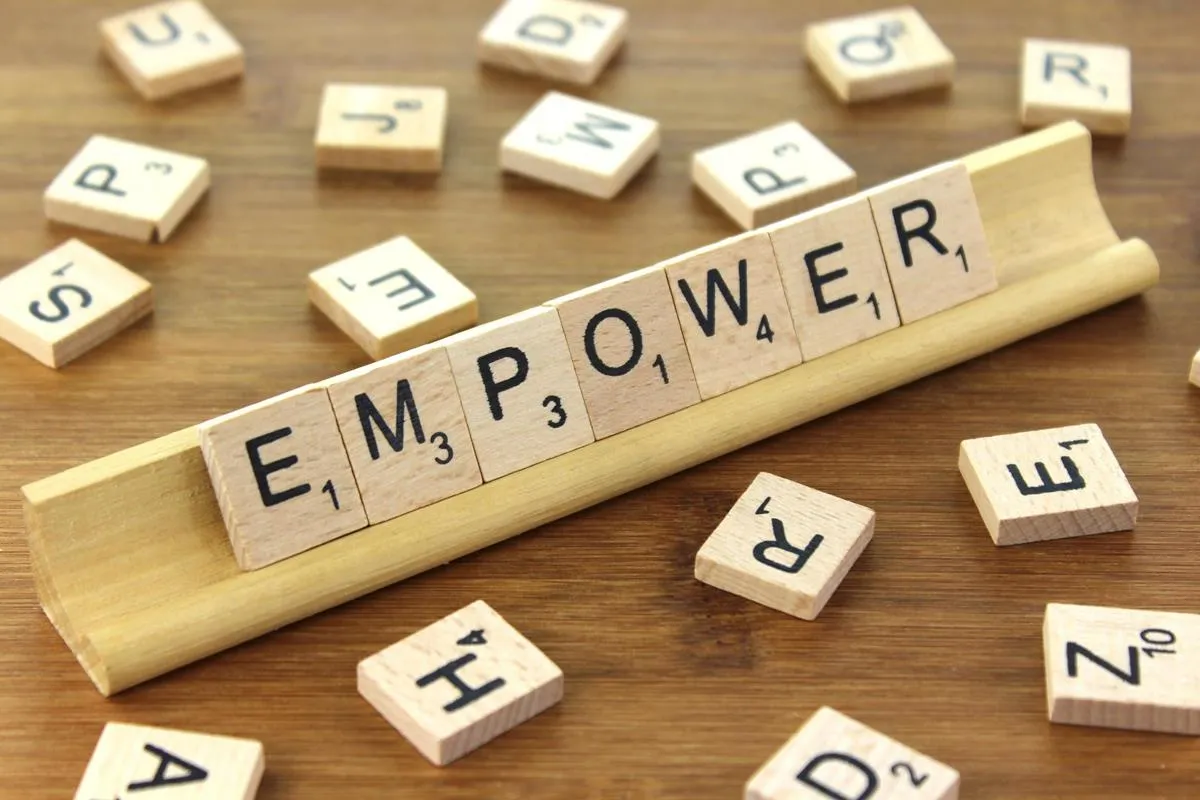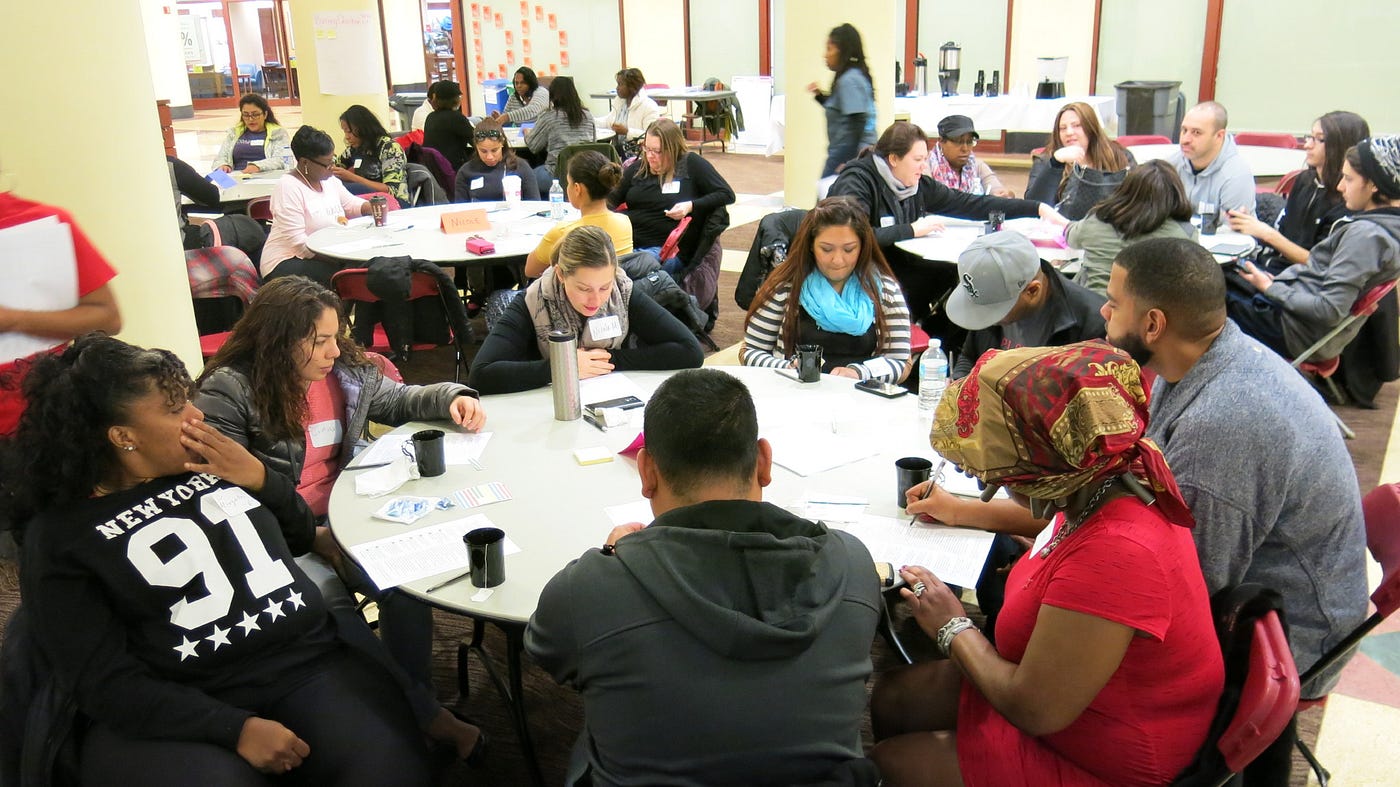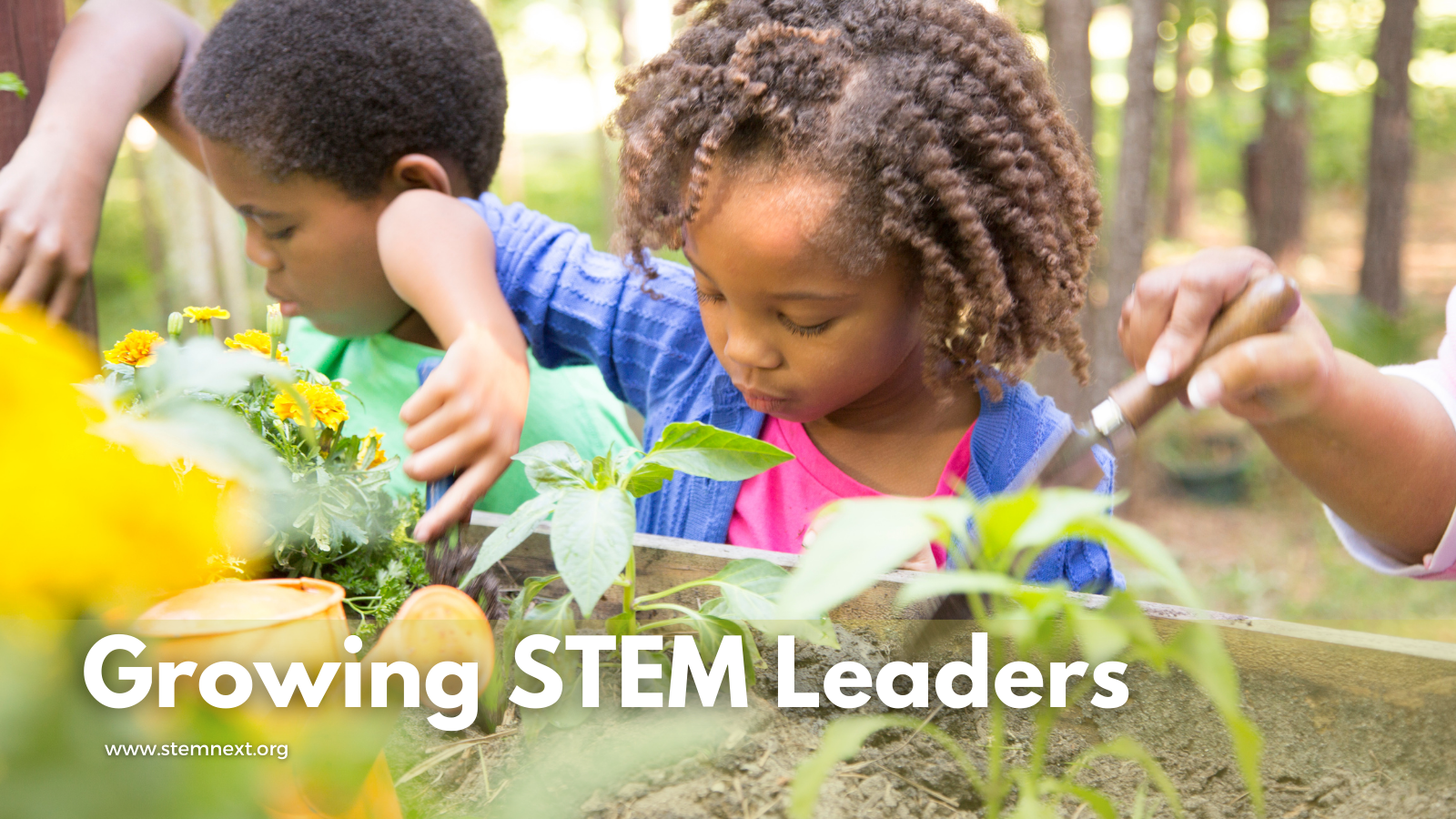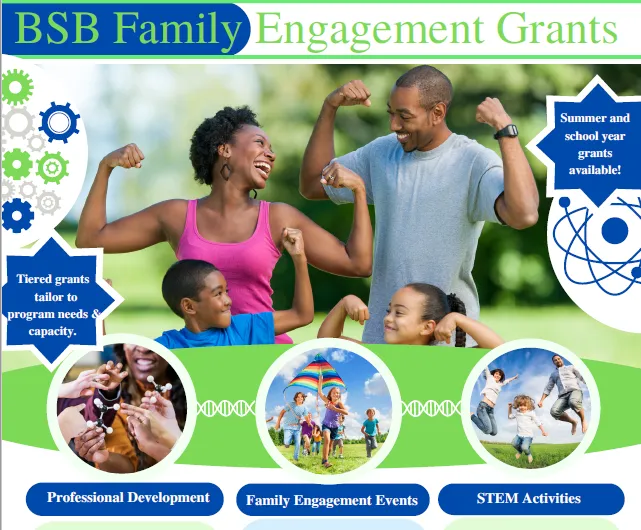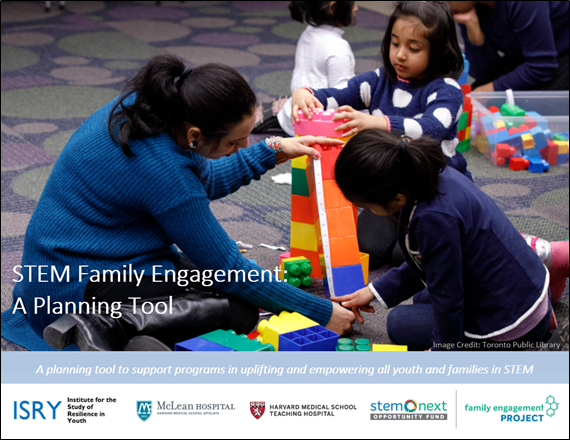Families are children’s first and consistent educators. Tapping into family engagement strategies can be the “secret sauce” to supporting a child’s engagement in science, technology, engineering, and math (STEM). When families learn and play together, the possibilities for children to explore new talents are endless. These opportunities help build confidence and creativity and may inspire a lifelong passion for STEM.
STEM Next Opportunity Fund believes passionately in the power of families to transform a child’s excitement for STEM. In support of families, STEM Next supports research, resources, and training for impactful family engagement. The Family Engagement Project offers practical ideas for putting research into action and real-life examples of ways to overcome barriers and support all youth and families in STEM. The work is guided by STEM Family Engagement: A Planning Tool and Workbook, which elevate evidence-based best practices and facilitate professional development for impactful and equitable family engagement. The Planning Tool is organized around the CARE framework: Connect, Act, Reflect, and Empower.
This blog is the first in the series, Growing STEM Leaders through Family Engagement, that posts throughout the 2023–2024 school year. This blog is all about empowerment, in support of children’s interest and persistence in STEM. We hope that the ideas in this blog will help you to support families as partners in shaping their children’s enthusiasm for STEM.
1. Empower caregivers
Encouragement is a caregivers’ superpower, although they may not know it. By giving caregivers examples of STEM in their everyday routines, you can tap into their existing knowledge and skills, rather than adding to their workloads or anxieties.
Empowering caregivers in action
We love how the following example shows how to bridge research and practice and most importantly, how to create opportunities for families to connect and share resources to help navigate STEM pathways.
Building on the Digital Youth Network model developed by Nichole Pinkard and research on parents as learning partners led by Brigid Barron, the team at Digital Youth Divas focused on ways in which parents support their children in STEM. These include teaching skills like how to use a power tool or sewing machine, working and learning alongside their child, and learning from their child.
The team at Digital Youth Divas intentionally decided not to present this research as top-down information from experts, but instead they shared the research and supported active discussions among families. After learning about the various roles that parents play in supporting youth learning, parents break up into small groups and share examples of the roles they play. The groups also discuss roles for which they need additional help in developing.
This active approach to engaging with research helps parents affirm all the work they are already doing to support their daughters and validate the roles played by other people including grandmothers, teachers, and coaches. The use of a self-affirmation approach can be especially encouraging for parents without a STEM background who are unsure of what they need to do to best support their children, validating that they are on the right track and are learning how to better support their children’s STEM education. By providing time and a variety of ways for parents and caregivers to learn together, Digital Youth Divas creates social networks in which parents become resources for one another. Families share opportunities in the community like summer workshops, weekend events at museums, and scholarships for STEM programs.
2. Empower youth
When we think about family engagement, we often put our energies into planning STEM events for families. Program staff focus on adults. They plan and prepare for how best to invite, welcome, and host activities for parents and caregivers. What’s missing from the equation? Youth. While often an untapped resource, youth know their families and can help share insights into what families are interested in and how to engage them. Invite youth to the table and listen to their ideas for family engagement. Let them help lead in planning and hosting STEM in afterschool programs, in the community, and at home.
Empowering youth in action
We love how Project Pride in Hamlin, WV flipped the typical family engagement model and supported youth so that they took the lead designing and hosting STEM workshops. In this case, girls in grades 6–7 created programs for their grandparents. They connected STEM with their grandfamilies’ everyday experiences with fishing, cooking, hunting, and playing ball. They interviewed their grandparents and recorded their stories. The project preserved history and showcased technology for social good. The girls were empowered and grew in confidence. The grandparents appreciated how their granddaughters engaged with them and how the project empowered their families. In light of the project’s success, the Project Pride team is making plans to do more to bring grandfamilies together to learn from one another. You can learn more in this program highlight of Project Pride in a rural community by Patty Allen.
3. Empower staff
Like STEM, family engagement requires repeated hands-on practice to build the family engagement “muscle.” However, out-of-school-time leaders and practitioners are likely to have limited experience working with families. Before we can empower families in STEM, we need to empower staff. They don’t just need to know STEM content. They also need to understand how to support family engagement in STEM.
Empowering staff in action
Nebraska’s Statewide Afterschool Network, Beyond School Bells, ran with the ideas from the community of practice on family engagement hosted by STEM Next. With resources from the training, Beyond School Bells put together packages of mini grants for NE afterschool programs. These grants went beyond supporting family events. They include support for professional development around engaging families through STEM; practicing multifaceted, regular communications with families; and holding STEM-based family engagement events with meals.
The STEM Family Engagement Planning Tool and Workbook were core to these grants. Program engagement in the CARE framework opened the door to the advanced CARE domain, Empower, in unexpected ways. The Empower domain focuses on deepening caregiver engagement through building welcoming and inclusive programs by inviting families to become not only welcome guests, but active partners and leaders.
The unexpected outcome was that working within this framework also empowered afterschool staff. For example, at Super Kids Club, Inc. in Broken Bow, the Director reported that staff were excited to work the CARE framework into their program. The professional development meetings and event planning supported through the grant led to staff showing increased engagement in their jobs and a reevaluation of practices which empowered staff, including high school staffers, to more directly communicate with families.
We were a top-heavy program where the Program Director was taking on all communication responsibilities and staff found that frustrating. This grant sparked conversations between the site leadership team and site staff that shifted responsibilities for each role. Site staff wanted to communicate with families about their programs and experiences with students which was not known by the site leadership team. This revelation motivated site leadership to coach site staff on communicating with families and to start including a site communications agenda item at all staff meetings so that site leadership and staff can work together to reach families each month.
Beyond School Bells learned that in order to engage with families at a deeper level of empowerment, it is important that staff also feel empowered. In fact, highly engaged and empowered staff may be a precursor to highly engaged and empowered families.
4. Support professional development and set the stage for empowerment
Just as impactful STEM engagement requires sustained opportunities, so too does professional development. Out-of-school-time leaders and practitioners are looking for practical ideas for putting research into action and for real-life examples of ways to overcome barriers. STEM Next offers professional development through communities of practice on a number of STEM topics including family engagement. Through these opportunities, participants reflect, share strategies and resources, and create an action plan with partners for greater collective impact.
We couldn’t be more pleased that the seeds planted with our resources are taking hold in communities across the country. The West Virginia Statewide Afterschool Network led its own community of practice to deepen its family engagement for 10 afterschool programs in partnership with the West Virginia Department of Education, West Virginia Department of Health and Human Resources, and the EdVenture Group. We highlight this example in the hopes that it will inspire you to imagine how you can deepen your support for professional development.
We are seeing the power of STEM Networks coming together to deepen family engagement through the CARE framework. Impactful family engagement takes time and resources to build and at its best, it empowers staff, caregivers, and youth in STEM.
Linda Kekelis: I am an advisor on family engagement for STEM Next. I’ve devoted my lifetime to supporting families and educators in encouraging youth in STEM. I am grateful to all the families I’ve met who shared their hopes, dreams, and ideas that have helped me appreciate the power of family engagement. I am grateful to partners like Alison who share their experiences and help me better understand the needs and strengths in their community.
Alison O’Toole: I am the Associate VP for Nebraska’s Statewide Afterschool Network, Beyond School Bells (BSB). Over the two years, I have been on the BSB team, it has been a joy to serve as a conduit for high-quality resources, such as the STEM Family Engagement Planning Tool and Workbook, to reach NE afterschool programs and have a positive impact on staff, students, and families. We are grateful for the resources STEM Next provides and for their willingness to engage partners like us on a deeper level so that learning becomes a conversation where participants are valued and resources reflect dynamic exchanges of lessons learned on the ground and high-quality research.
For STEM Next, family engagement is essential in accomplishing its big new goal of inspiring 20 million more young people with STEM opportunities by 2027. STEM NEXT supports family engagement by empowering networks of organizations that offer STEM programs in out-of-school time. With case studies, blogs, and white papers STEM Next highlights promising practices and research. These include Changing the Game in STEM with Family Engagement, The Essential Funders’ Guide to STEM-Focused Family Engagement, and Field Guide: How to Host a Community of Practice.


